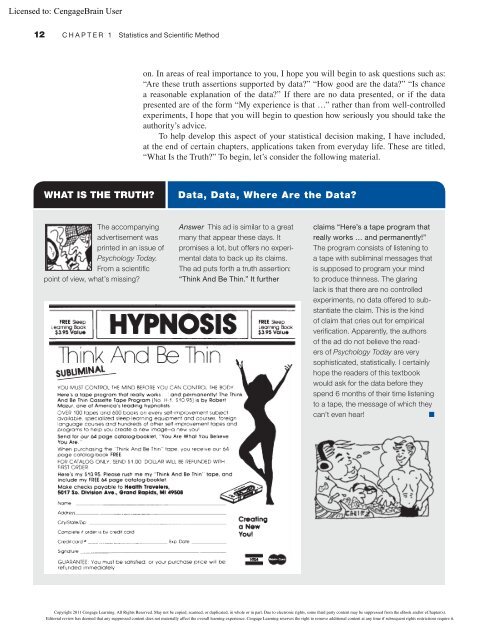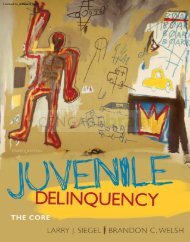Understanding Statistics in the Behavioral Sciences ... - NelsonBrain
Understanding Statistics in the Behavioral Sciences ... - NelsonBrain
Understanding Statistics in the Behavioral Sciences ... - NelsonBrain
Create successful ePaper yourself
Turn your PDF publications into a flip-book with our unique Google optimized e-Paper software.
Licensed to:<br />
12 C H A P T E R 1 <strong>Statistics</strong> and Scientifi c Method<br />
on. In areas of real importance to you, I hope you will beg<strong>in</strong> to ask questions such as:<br />
“Are <strong>the</strong>se truth assertions supported by data?” “How good are <strong>the</strong> data?” “Is chance<br />
a reasonable explanation of <strong>the</strong> data?” If <strong>the</strong>re are no data presented, or if <strong>the</strong> data<br />
presented are of <strong>the</strong> form “My experience is that …” ra<strong>the</strong>r than from well-controlled<br />
experiments, I hope that you will beg<strong>in</strong> to question how seriously you should take <strong>the</strong><br />
authority’s advice.<br />
To help develop this aspect of your statistical decision mak<strong>in</strong>g, I have <strong>in</strong>cluded,<br />
at <strong>the</strong> end of certa<strong>in</strong> chapters, applications taken from everyday life. These are titled,<br />
“What Is <strong>the</strong> Truth?” To beg<strong>in</strong>, let’s consider <strong>the</strong> follow<strong>in</strong>g material.<br />
WHAT IS THE TRUTH? Data, Data, Where Are <strong>the</strong> Data?<br />
The accompany<strong>in</strong>g<br />
advertisement was<br />
pr<strong>in</strong>ted <strong>in</strong> an issue of<br />
Psychology Today.<br />
From a scientifi c<br />
po<strong>in</strong>t of view, what’s miss<strong>in</strong>g?<br />
Answer This ad is similar to a great<br />
many that appear <strong>the</strong>se days. It<br />
promises a lot, but offers no experimental<br />
data to back up its claims.<br />
The ad puts forth a truth assertion:<br />
“Th<strong>in</strong>k And Be Th<strong>in</strong>.” It fur<strong>the</strong>r<br />
claims “Here’s a tape program that<br />
really works … and permanently!”<br />
The program consists of listen<strong>in</strong>g to<br />
a tape with sublim<strong>in</strong>al messages that<br />
is supposed to program your m<strong>in</strong>d<br />
to produce th<strong>in</strong>ness. The glar<strong>in</strong>g<br />
lack is that <strong>the</strong>re are no controlled<br />
experiments, no data offered to substantiate<br />
<strong>the</strong> claim. This is <strong>the</strong> k<strong>in</strong>d<br />
of claim that cries out for empirical<br />
verifi cation. Apparently, <strong>the</strong> authors<br />
of <strong>the</strong> ad do not believe <strong>the</strong> readers<br />
of Psychology Today are very<br />
sophisticated, statistically. I certa<strong>in</strong>ly<br />
hope <strong>the</strong> readers of this textbook<br />
would ask for <strong>the</strong> data before <strong>the</strong>y<br />
spend 6 months of <strong>the</strong>ir time listen<strong>in</strong>g<br />
to a tape, <strong>the</strong> message of which <strong>the</strong>y<br />
can’t even hear! ■<br />
Copyright 2011 Cengage Learn<strong>in</strong>g. All Rights Reserved. May not be copied, scanned, or duplicated, <strong>in</strong> whole or <strong>in</strong> part. Due to electronic rights, some third party content may be suppressed from <strong>the</strong> eBook and/or eChapter(s).<br />
Editorial review has deemed that any suppressed content does not materially affect <strong>the</strong> overall learn<strong>in</strong>g experience. Cengage Learn<strong>in</strong>g reserves <strong>the</strong> right to remove additional content at any time if subsequent rights restrictions require it.















